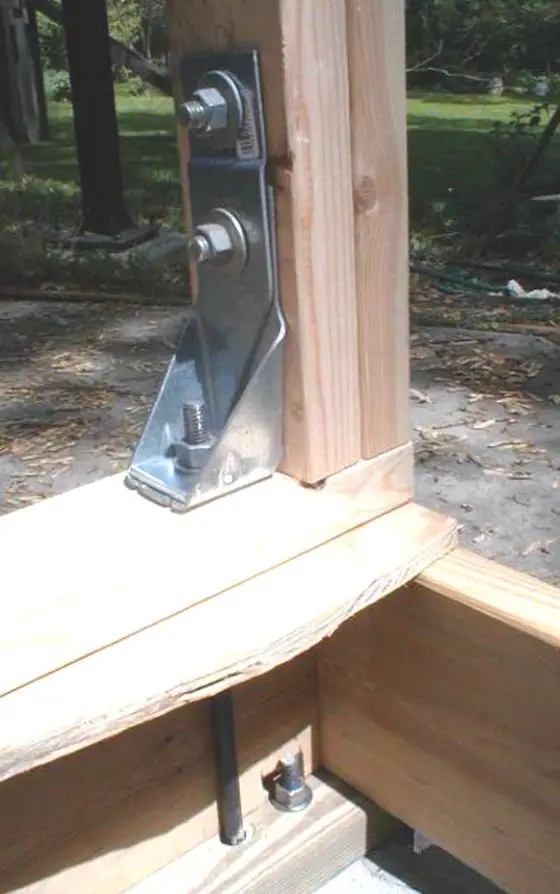Metal Connectors Minimize Wind / Storm Damage

The large metal connector is through bolted to the walls studs. the connector itself is connected to the foundation with the long black anchor bolt. Imagine how well these connectors hold instead of 16d nails!
DEAR TIM: I live in an area that gets just about every type of wind storm. Tornadoes have touched down very close to my existing home and I have been through several hurricanes. I am getting ready to build a new home. What can I do to hold it together as long as possible during violent windstorms? I can't build a basement. Is there a way to construct an internal shelter within my home that I can use in the event of a killer storm? Tracy G., Mobile, AL
DEAR TRACY: Anyone who watches the evening news knows that tornadoes, hurricanes and even severe thunderstorms can create winds that blast apart homes and families. Virtually every part of the United States can experience a weather event that can cause significant damage to a typical residential home. No one is really immune from a wind related personal or property loss.
Believe it or not, a majority of tornadoes produce wind speeds of 112 miles per hour or less. Residential homes that are constructed in strict accordance to most model building codes can withstand winds of this nature. The trouble is, it is virtually impossible for most building inspectors to insure that each and every nail, screw, anchor bolt, etc. has been put in exactly to code specifications.
The trick to making a wood framed structure extremely wind resistant is to create a continuous connection path from the roof rafters or trusses all the way down to the foundation. Many carpenters make an attempt to do this by using 16 penny hand driven nails fastened into all of the wooden framing components. If you want these nails to hold down the house in windy weather, they have to be driven in strict accordance with the building code. In many instances the wrong nails are used or the spacing between nails is too great.
Perhaps the best nails to use when building a home are ones driven by a pneumatic nail gun. These nails are coated with a special lubricating glue that melts as the nail glides into the wood. The glue hardens within seconds and produces greater holding power than an equal sized and shaped hand driven nail.
One of the best ways to attach walls, floors and roof structures directly to the house's foundation is to use readily available, inexpensive metal connecting plates and anchors along with approved structural nails. In a typical house, only the treated sill plate is firmly bolted to the foundation. There are numerous easy-to-install metal connectors that allow you to quickly bolt floors and walls to the foundation and then connect every other major wall, floor, or roof section to the components below. This provides a continuous metal connection path from the roof down to the foundation.
The cost for the nifty metal connectors in a typical house is less than $200. The labor to install them should average $300 or less. Although they may not keep your house together, if it suffers a direct hit from a very powerful wind storm, they may keep the roof on and the exterior walls from blasting apart long enough for you to seek shelter in a safe place.
Recent findings at Texas Tech University have shown that people who live in houses lacking basements can build interior storm shelters within their homes. The trick is to create a normal looking storage closet that consists of steel reinforced solid masonry walls, a poured-in-place concrete roof, vents to compensate for air pressure changes, and a well built pocket or sliding door that is made with several sheets of 3/4 inch plywood and covered with 14 gauge metal. This above ground shelter will resist wind blown debris, air borne missiles, etc. that can cause severe injury and/or death in a violent storm.
The size of an interior shelter depends upon how many people you want to place in it. It doesn't have to be extremely large, as most violent wind storms can last anywhere from several minutes to several hours in the case of a large hurricane. The point is you just need to be able to sit down and relax as much as possible during the storm. If you decide to build one, make sure it is stocked with several flashlights, a battery operated radio, and perhaps some bottled water and a first aid kit.
Companion Articles: Interior Hurricane - Tornado Shelter, Fight Hurricane & Tornado Storms with Metal Connectors, Underground Tornado Storm Shelter, Tornado & High Wind Damage
Column 269